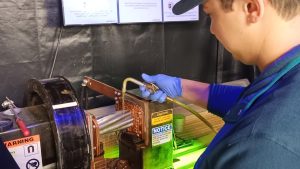A few years ago, roofing contractors were hit by huge increases in the cost of liability insurance, inflamed by a combination of insurance industry woes and some high-profile roofing industry incidents involving torch-applied roofing fires.
Roofing Contractors
Roofing associations decided to tackle rising premiums by learning more about the insurance business
TORONTO
A few years ago, roofing contractors were hit by huge increases in the cost of liability insurance, inflamed by a combination of insurance industry woes and some high-profile roofing industry incidents involving torch-applied roofing fires.
Roofing associations in British Columbia, Alberta, Ontario and Quebec dealt with premium spikes by partnering with professionals to learn more about the insurance business themselves.
The Alberta Roofing Contractors Association (ARCA), like the Association des Maitres Couvreurs du Quebec (AMCQ), decided that self-insurance was the best solution under an arrangement known as an insurance reciprocal.
ARCA approached Tailor Made Insurance Service, a broker in Sherwood Park, Alberta, to put together a package for its members.
“It got to the point where, three or four years ago, some premiums were larger than payrolls,” says Alan Wood, a broker with Tailor Made. “In our case, a group of 16 roofers decided to look after the first $100,000 of any claim themselves — the majority of claims involved minor amounts — then purchased excess insurance.”
The excess insurance was purchased in bulk from a Quebec company which also covered the AMCQ plan.
Roofers had to be ARCA members, allowing them to establish an underwriting standard based on what the association requires, guaranteeing a level of safety and risk management professionalism.
“If the roofers wanted to place other requirements on the members, they could vote to do so,” says Wood.
One advantage of the insurance reciprocal is that members can recoup unclaimed plan surpluses. The Alberta plan has finished its third year with a surplus.
Different regulations governing insurance required a made-in-B.C. solution for members of the Roofing Association of British Columbia (RABC).
“B.C. is the only province that allows the formation of what’s known as a captive insurance program, a program set up specifically for its members,” says Brian Hofler, executive vice president of the RABC.
“We put a team of legal and financial experts together — people with a knowledge of the insurance industry — to identify the best options.”
RABC companies pooled one million dollars, then approached individual re-insurers, explaining what type of coverage was required.
“Members weren’t required to join,” says Hofler. “We made a good business case for joining and 63 per cent of our members signed up.”
Ontario roofers began experiencing problems with insurance costs as early as 2001, with premiums rising through 2003.
“While other roofing associations went into self-insurance, we didn’t want to get into the insurance business,” says Don Marks, executive director, of the Ontario Independent Roofing Contractors’ Association (OIRCA).
“Because the size of projects in Ontario can be much larger than elsewhere, the liabilities are much larger.”
The Ontario solution was to find a better insurance deal within the existing insurance market.
“We found the deal we were looking for outside the country with an Australian company,” says Simon Fenn, president of Fenn & Fenn Fenn Insurance of Newmarket, who brokered the deal.
“That Australian company was originally not licensed to operate in Canada, so we fronted the policy through a Canadian company until it could be covered by Lloyd’s of London which is licensed to operate here.”
A year into the policy about 30 per cent of OIRCA members are insured through the package.
Roofing association success has insurance companies across Canada wooing roofers once again. One reason is that roofers with the best safety records were most likely to sign up with policies offered by local associations, leaving roofers with less stellar track records in traditional plans.
“The price a year ago for roofing insurance was exorbitant, but since then has completely softened and they’re offering more capacity,” says Fenn. “Before, they might have offered a million dollars — today it’s five million and ten million dollars. Roofers can find coverage through a variety of solutions, and we’d like to think we were a part of that.”










Recent Comments
comments for this post are closed